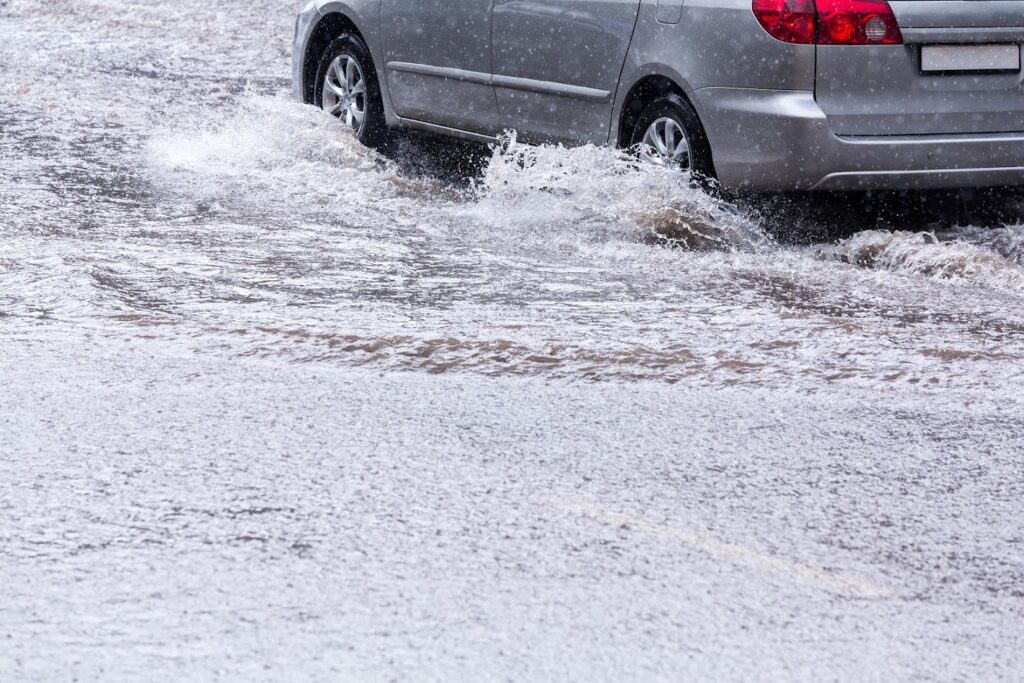Tips for Safe Driving in the Rain

Driving in the rain is often more dangerous than driving in good weather. Rainfall can reduce visibility and make the road’s surface slippery. Use the following tips to drive safely in the rain.
Slow Down
The speed limits you see on road signs apply for perfect weather. Slow down well below the stipulated speed limit if driving in the rain. Driving fast in the rain often increases your risk of skidding and losing control of your car.
The risk of skidding increases because of the film of water that can separate your car’s tires from the road’s surface. The phenomenon, known as hydroplaning, leads to traction loss. Traction loss leads to loss of steering, braking, and even steering, which causes skidding.
Increase Your Following Distance
Increase the distance between you and the car in front. The increased distance will give you ample time and space to stop in case of an emergency. More time and space are necessary because braking is more difficult on slippery surfaces than other surfaces.
For example, you might need to stop fast if the car in front hits a deep pothole. You can easily rear-end such a car if you do not have an ample following distance.
Increase Visibility
Rainfall reduces visibility in various ways. For example:
- Raindrops scatter light and trigger blurry vision
- Water triggers mud that clogs windshields
- Humidity causes condensation in auto glass
Take measures to ensure you can see other road users, and they can see you. For example, you should:
- Ensure that your windshield wipers are working — and use them
- Defrost the windshield to clear condensation
- Turn on your lights
Improved visibility will help you see potholes, stalled trucks, fallen rocks, and other accident risks.
Avoid Sudden Movements
Sudden movements are dangerous in the rain. The reduced traction means that your car might not do what you want it to do with a sudden maneuver. For example, you should not:
- Brake hard
- Accelerate fast
- Swerve sharply
Make every maneuver gently and deliberately to avoid mishaps. For example, your car might skid and swerve into the next lane if you brake hard. The skidding might cause you to crash into nearby road users.
Stick to Known Roads
Driving in the rain is often more dangerous on unfamiliar roads than on familiar ones. With the familiar roads, you at least know where the dangers are — dangers such as potholes, landslides, or falling rocks. On an unfamiliar road, you can easily drive into what you think of as a puddle of water only to drive into a deep pothole.
If you have to drive on an unfamiliar road, do what the other cars are doing. For example, slow down if the car ahead slows down and follow in the tracks of the car ahead of you.
Know When to Stop
The rain intensity, route familiarity, car condition, and nature of the road all determine how safe driving should be. Know when the conditions become too dangerous for you to drive and stop. For example, you should pull off to a safe area if:
- You cannot see other motorists
- You are not sure how deep the potholes are
- Strong winds accompany the rainfall
- The vehicles ahead of you are really struggling
Be the judge of the conditions and your capabilities, but err on the side of caution.
Never admit liability for an auto accident even if you feel you are to blame. The confusion you are likely to feel after an accident can cloud your judgment. Preserve as much of the evidence as possible, and contact The Wenck Firm. We will review the circumstances of the crash and help you pursue all the damages you deserve. We look forward to meeting with you soon to discuss your case.
This Blog/Web Site is made available by The Wenck Firm, LLC, for educational purposes. It provides general information and a general understanding of the law, but does not provide specific legal advice. By using this site, commenting on posts, or sending inquiries through the site or contact email, you confirm that there is no attorney-client relationship between you and the Blog/Web Site publisher. The Blog/Web Site should not be used as a substitute for competent legal advice from a licensed attorney in your jurisdiction.
